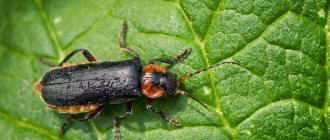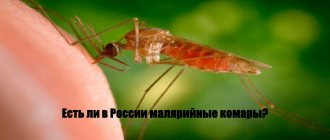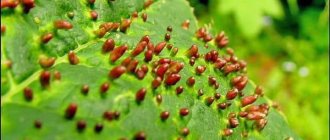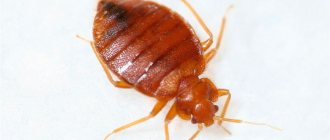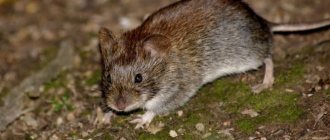- Wild animals
- >>
- Mammals
There are a lot of animals in nature that know how to dig tunnels underground. However, the most famous digger, known since childhood, is the mole . This mammal spends most of its life underground, which is facilitated by the special body structure and physical capabilities of the mole. This is a unique creation of nature, which brings both unconditional benefit and quite serious harm to humans.
Origin of the species and description
Photo: Mole
The mole is a very small animal with tiny eyes and strong paws that have the ability to dig through long underground passages. The eyes of some mole species are securely hidden under the skin. Moles do not have ears; they have smooth, very soft fur. The coat color is usually black, but there are also animals with a dark gray “fur coat”.
Moles are classified as insectivores, which belong to the broad class of mammals. They are part of the mole family - lat. Talpidae. The animals got their name for a reason. Literally, the word “mole” means “digger.” The name comes from the word “dig, dig.”
Video: Mole
These underground inhabitants can make passages hundreds of meters long. Under the soil, the animal arranges a sleeping place for itself and makes special corridors in which it hunts. Moles prefer to spend the night on moss, grass or leaves. They are quite intelligent animals, so a secret passage is always provided in the “bedroom” for retreat in case of danger. The underground passage is covered with bedding.
Interesting fact: Constant movement through narrow earthen passages is reflected in the appearance of the animal. Gradually, the mole wears off its fur, remaining completely bald. However, nature has provided for everything - moles grow a new “coat” 3-4 times a year.
Moles also equip their homes with additional passages to a water source. Some animals create their own underground wells. Wells fill with water during heavy rains. In winter, such animals prefer to hide deep in the ground. At great depths, the earth remains warm and does not freeze.
A little about the mole’s nutritional “culture”: when, how and how much does it eat?
The mole eats a lot and often. During the day, he eats about 5-8 times, crawling out of the nesting chamber in which he rests, and for a very long time collecting food in the feeding passages.
Between meals the animal rests and sometimes sleeps.
On a note
Digestion of a portion of food lasts about 4-5 hours for a mole. After this time, the animal becomes hungry again, and after 16-17 hours, if it does not find food, it weakens and quite quickly dies from hunger. Thus, the mole literally needs to constantly eat.
In one sitting, a mole eats about 15-20 grams of food, and in a day - about 50-60 grams. As a rule, he needs an amount of food per day that is 60-70% of his body weight, although in times of hunger he can “get by” and 20-30%. And on “fat” summer days, while fattening up, the animal can eat as much as it weighs.
It is also useful to read: Interesting facts about the life of the star-nosed mole (star-nosed mole)
It may seem that the mole eats a lot (if a person consumed the same amount of food in relation to his weight, he would have to eat 40-50 kilograms of meat per day). Such gluttony of animals looks fantastic, but from a scientific point of view it is quite easily explained:
- Moles have a very fast metabolism. This means that the food consumed is converted into energy or fat reserves in their body within a few hours. After this, the animal needs to eat again;
- Moles are very active and spend a lot of energy. Only those who have not seen them might think that they are clumsy, slow animals. In fact, the mole is very fast, and if it does not sleep, it is constantly in motion, which means it constantly wastes energy that needs to be restored;
- In search of food, the mole does a lot of hard work, so to speak. Figuratively speaking, his energy investments in searching for food are very large, and in order to at least “beat them off”, he needs to eat a lot. To understand this statement, imagine that in order to get a portion of food you need to dig a hole in the ground with a diameter equal to the width of your shoulders and a length of about a meter. Also imagine how much energy you will spend on this and what the portion of food should be in order to at least restore strength after such work;
- Due to the small size of the mole's body, heat transfer in relation to its mass is significantly higher than that of larger animals. This means that, constantly staying in cold ground, an animal needs more food to maintain body temperature than, say, a person or a dog.
When feeding, the mole sometimes simply moves along the passage, picking up its victims in it, and when it is full, it moves into the residential passage and rests there. If necessary, the animal begins to dig new passages.
In winter, the mole requires slightly less food than in summer, due to which it can survive in conditions of a reduced amount of food.
There are no pronounced fluctuations in daily feeding activity in moles. Except that at night the animals more often dig new tunnels and come to the surface, so at night they consume less food. But in general, these animals eat and rest approximately evenly throughout the day.
Appearance and features
Photo: Animal mole
The main feature of these small animals is the lack of vision. If for humans and other animals the lack of vision is a serious defect, then for moles it is considered the norm and even a necessity. Having normal eyes, these animals simply would not be able to spend almost their entire lives underground. Moles have eyes, but in most species they are additionally protected by a layer of skin.
Not only the organs of vision are completely adapted to underground life. The hearing organs are also adapted to it. Moles do not have ears. This is also not just provided by nature. If there were ears, then too high pressure would form in them. Such pressure would not allow the animal to be in the soil.
Diggers have fur that is very pleasant to the touch. It also has some features that differ from the fur of other animals. The mole fur covering can be easily folded in different directions. This property allows animals to slip into narrow underground tunnels without problems. The color of the fur is usually black, brown or dark gray.
The appearance of moles can be characterized by the following parameters:
- The total length of the animal is about sixteen centimeters. Of this, the body occupies approximately seven centimeters, and the rest is the length of the head and tail.
- The average weight of the animal is fifteen grams. However, representatives of the family of larger sizes are known. For example, scientists came across the Ussuri mogera, whose length is twenty-one centimeters.
- The body shape of this mammal is bar-shaped. Moles have a tiny head and an almost invisible neck. The auricles of most members of the family are undeveloped, while in others they are very small and covered with hair. Animals also have a nose in the form of a small proboscis. It contains sensitive hairs. The nostrils are directed forward.
- The mammal's paws have five toes. They are the main tool for digging long tunnels. The paws are strong and have claws. The hands resemble shovels; they are turned with the palms facing outward. The mole digs tunnels with its front legs, while its hind legs are less strong. They are very thin and resemble the paws of rats.
Types of moles with photos and names
Today, about 40 species of these animals are known to exist. The most famous types are:
Common mole (Talpa)
Adults grow from 12 to 16 centimeters in length, while gaining weight from 50 to 90 grams. The length of the tail is from 2 to 4 centimeters. In place of the eyes there are narrow slits, while the eyelids are motionless. The main color is black, but in the belly area it has a lighter color. Young individuals are characterized by having a lighter coat compared to older moles. They breed once a year. Moles of this variety are found almost throughout the Euro-Asian continent.
Blind mole (Talpa caeca)
It is considered one of the smallest representatives of this species of mammals, since its body length is from 8 to 12 centimeters, and the tail length is no more than 3 centimeters, with a weight of no more than 30 grams. The mole has no eyes at all, since they are covered with skin. The diet of this species includes various insects and their larvae, although it can also feed on earthworms. The breeding process begins with the onset of spring, when the snow just begins to melt. Natural habitats are associated with the mountainous regions of Turkey, the Caucasus, and Northern Iran.
Long-tailed mole (Scaptonyx fusicaudus)
It is distinguished by its even smaller size, as it grows in length up to 9 cm and no more, while its tail is relatively large and reaches a size of 4.5 cm. The body is covered with quite hard fur. Prefers to live in the highlands of Northern Vietnam, Southern China and Northern Iran with the presence of coniferous plantations. They dig underground passages at shallow depths.
Caucasian mole (Talpa caucasica)
It is distinguished by its average size, reaching from 10 to 14 centimeters, with a weight from 40 to 85 grams and a tail length of no more than 3 centimeters. It acquires a brown tint after the molting process. The animal is practically blind, since its eyes are located under the skin. It digs underground labyrinths at a depth of no more than 20 centimeters. The basis of its diet is earthworms, although it can also feed on various insects. It breeds once a year. It lives in the Ciscaucasia, Transcaucasia, and also in the Greater Caucasus.
Siberian mole (Talpa altaica)
It has a slight resemblance to the European mole, but is somewhat larger in size. Adult males can range from 13 to 19 centimeters in length, weighing from 70 to 230 grams, with females being slightly smaller. The tail of these animals is also relatively short, no more than 6 centimeters long. The eyes have a movable eyelid. The main color of the animal is almost black or dark brown, while there are albinos, as well as red, yellow or spotted individuals. The diet consists of various insects, as well as earthworms. The peculiarity of the Siberian mole is that the female carries her future offspring for 9 months. This is due to the developmental characteristics of the embryo. Despite the fact that individuals mate in the summer, the embryos begin to develop only with the arrival of spring. Future offspring are born no later than the end of May.
Japanese shrew mole
It grows in length up to 10 cm maximum, while the length of the tail is only 3 cm. The tail is covered with hair, and there is a tassel at its end. The coat is not distinguished by the presence of a characteristic shine, but it is thick and soft, either black or black-brown. Can overwinter in bird nests. Inhabits the mountain slopes of the southern islands of Japan. It breeds once a year.
Japanese mogera (Mogera wogura)
Individuals of this species grow to a maximum length of 15 centimeters, while the length of the tail is only a little over 2 centimeters. Adult individuals weigh on average about 150 grams, although more massive individuals are also found. The main color is black, brown and gray, with the abdominal area being painted in lighter colors. The animal feeds mainly on insect larvae, but on occasion it can also dine on earthworms. Underground labyrinths are distinguished by a 2-level scheme. The first level is at a depth of about 70 cm, and the second level is at a depth of up to one and a half meters.
Starburst (Condylura cristata)
It has a body up to 20 centimeters long or a little more, while the tail is relatively long, almost 8 cm in length. The tail is scaly, covered with sparse hairs. In winter the tail becomes thicker. The animal does not have ears, but you can see very small eyes. The coat is thick, black or dark brown. The uniqueness of the species lies in the presence of a special stigma, somewhat similar to a star, formed by two dozen fleshy processes. This stigma helps the animal in search of food. The two upper processes, which are directed upward, are motionless, and the rest are mobile and quite sensitive. This animal is an excellent swimmer and feels great even under ice. Therefore, its diet consists of fish, as well as earthworms and mollusks. Easily moves both on the ground and in the snow. The most favorite habitats are associated with the moist soils of the southeastern United States, as well as Canada.
Where does the mole live?
Photo: Soil animal mole
Representatives of the mole family are widespread. They live throughout Eurasia and North America. In South America, moles are completely absent. Scientists have concluded that these animals settled in North America when it was separated from the South by the Strait. Moles live in especially large numbers in Russia, Belarus, Poland, Ukraine, Georgia, and Moldova.
In particular, four species of moles live in Russia:
- Blind. It is distributed from Ciscaucasia to Transcaucasia. Representatives of this species can often be found in Turkey and even in Northern Iran. The animal lives in mountains, alpine meadows, and is sometimes found in forest landscapes. To live, blind moles choose loose, moist soils. Sometimes these animals live together with the Caucasian species;
- Caucasian. It settles in the central, western parts of the Caucasus, and is found in some areas of Turkey, which are adjacent to the shores of the Black Sea. Caucasian moles live mainly in deciduous forests, but in small numbers they are found in mountain meadow biotopes. In search of food, such animals can go to a depth of up to one meter. The main passages are located quite close to the surface - at a distance of five centimeters;
- Altaic. It has a uniform coat color, the fur on the belly is matte. The appearance of Altai moles is completely consistent with moles. The body of the animal is quite massive and round;
- Ordinary. This is the group of the most common moles. Its representatives can be found in various landscapes: from forests to mountains.
For a normal life and reproduction, moles need special conditions. For this reason, they choose areas with moist soil. It is most suitable for digging tunnels. The terrain of the area can be almost anything. The animals prefer a moderate climate.
Lifestyle of moles
Moles mainly feed on food of animal origin, in the form of various insects. At the same time, they behave actively throughout the year. Moles spend the bulk of their lives underground. Here underground, at a depth of about 2 meters, they reproduce. Due to the fact that moles lead a secretive lifestyle, not everything is known about them to scientists.
The living conditions of these animals are related to the nature of the soil, which must be loose and sufficiently moist. Mole holes are located at a depth of 5-20 cm from the surface of the earth. Since the mole digs passages with its paws, the soil should not be dense and heavy. The animals push the excess soil that appears to the surface of the earth. Based on the lumps of fresh soil that appear on the site, we can conclude that moles have appeared on the site.
The mole makes deep moves in such cases:
- If you need to overcome a strip of trampled soil or for reproduction. In such cases, the wormhole may be at a depth of up to 1 meter, or even more.
- For greater reliability, the female builds her nest under the roots of trees at a depth of up to 2 meters.
- When there is a drought outside and all the food has gone to the depths.
If there is no need, then moles live and dig their tunnels at the same depth. If the depth is not great, then it is easier for animals to breathe and ventilate their nests.
On a note! The Caucasian mole, in order to feed itself, digs its tunnels to a depth of 1 meter.
It is believed that moles are more useful than harmful animals. The presence of mole holes allows the soil to be enriched with oxygen, which leads to improved growth conditions for various plants. The only people who see moles as their enemies are homestead owners and summer residents.
Why are such moves needed?
The main food item of moles is earthworms, which is why moles make tunnels in the ground to find worms. Worms feed on decaying organic matter, which is concentrated in the upper layers of the soil. The wetter the soil, the more worms that attract moles as food. At the same time, moles destroy various insects and their larvae that they encounter on their way.
Interesting to know! If a vole mouse ends up in the mole's feeding passage, the mole will easily deal with it.
Adult individuals are aggressive and will never tolerate a stranger on their territory, even if it is their relative: they can easily eat a baby or a weaker individual.
Each mole eats up to 60 grams of worms and various larvae per day. They have a fairly fast metabolism, as they need to spend a lot of strength and energy digging tunnels. For this reason, they can fast for no more than half a day, otherwise they may die of starvation.
Many people believe that moles also feed on plant roots. Actually this is not true. They can harm plantings of cultivated plants only because they make moves and at the same time can damage the root system.
With the onset of cold weather, moles do not hibernate, but it is quite difficult for them to eat fully, since earthworms burrow to a considerable depth, where moles cannot reach them.
Despite this problem, the mole must constantly eat, and live food. Therefore, moles stock up on earthworms for the winter, and to keep them alive and unable to escape, moles bite off their heads.
What does a mole eat?
Photo: Mole insectivore
Moles, although small, are quite voracious animals. They are active around the clock, but hunt more often at dusk. Animals have a high metabolism. In summer, moles eat in large quantities, and in winter, the diet and amount eaten decrease slightly. Animals prefer to live and hunt alone, but sometimes there are also representatives of the family living in groups.
The main part of the mole's diet is earthworms. Mammals eat them in the summer and store them for the winter, biting off the heads of the worms, paralyzing them. Moles also eat larvae of earthworms, larvae of click beetles, May beetles and other varieties of beetles. Flies, caterpillars, and slugs often end up in mole food.
The largest representatives of the mole family, mogers, prefer to feed on butterfly caterpillars. Star-nosed moths eat small aquatic inhabitants. They can feast on crustaceans, small fish and insects. American shrews include plant foods in their diet.
Interesting fact: A tiny mole can eat a huge amount of food in a day. The animal absorbs food, the weight of which is equal to the weight of the animal itself. Also, these mammals are quite thrifty. A mole can store about two kilograms of food in its nest for a rainy day.
In one day, the number of meals can reach six times. After each hearty meal, the mole falls asleep sweetly. Sleep duration is usually four hours. It is during this period of time that the food has time to be completely digested. The animals are not used to going hungry. They can live no longer than seventeen hours without food.
To find a fresh treat. moles do not have to dig new passages every time. They find food in old tunnels into which the worms crawl on their own. Worms are attracted due to the warmth and special smell of moles. In winter, members of the family also do not have to starve. Earthworms are no less active. They are able to make moves even in frozen ground.
General description of the species
Moles are a family from the class Mammals, belonging to the order Insectivores. They live in Europe, Asia and North America.
Appearance
The mole looks like a small animal, body length 5–20 grams, weight varies from 9 to 170 grams. Animals are adapted to underground life. The body is rounded, oblong, covered with velvety smooth fur. It always grows straight, which allows it to lie in any direction while digging.
The fur color is black or dark brown. The animal molts in spring, summer and autumn. The paws are small, the front paws are spade-shaped, the hind paws are underdeveloped.
Other external features include:
- small tail;
- a nose made in the form of a movable proboscis;
- absence of ears;
- small oblong head;
- externally invisible neck.
The eyes are poorly developed and lack a retina and lens. The eye openings are small, covered by movable eyelids. In some species, the eyes completely become overgrown. The animals have highly developed senses of hearing, touch and smell.
Characteristic
Moles by nature are predators that eat small insects and larvae. They prefer areas with soft, loose soil that is easy to dig with their paws. In summer, their tunnels are laid close to the soil surface.
In winter, animals go deep into the ground. They do not hibernate, but only greatly reduce their activity. They feed on stocks of worms that are kept alive but paralyzed. To do this, the animal bites off their head.
Habitat
Moles live everywhere in Eurasia and North America. In Russia they are found in the central zone, in the North Caucasus, the Urals and Western Siberia. In the east of the country they live up to the confluence of the Irtysh and the Ob. The northern border of the animals’ habitat runs along the Siberian taiga, and the southern border extends to the forest-steppe zone. All that is important for these animals is that the soil is suitable for digging. They are almost never found in swampy areas.
In Asia, moles are found in China, Turkey, Indochina, Tibet, Mongolia, and Transcaucasia. They are found in the western United States, southeastern Canada, and Mexico.
Population and status
The density of mole populations depends on both the specific species and the area. Males usually increase their density in the spring. In view of this, there are 5–30 individuals per hectare of soil.
Today they have emerged from the status of endangered animals. This is due to the fact that they are almost no longer hunted. Warm winters also have a good effect on the survival of animals.
Features of character and lifestyle
Photo: Common mole
Almost the entire life of a mole is spent in complete darkness. They build incredible labyrinths in which they then live and hunt. Labyrinths can lie at different depths in the ground. Digging takes an animal a lot of time. Above the passages, which are located close to the surface of the earth, you can always notice a characteristic roller. The depth of the labyrinths depends on the type of soil. If it is loose and wet, the passages are made at a shallow depth; in dry soil, channels are dug at a depth of twenty centimeters.
The deepest tunnels are dug by animals under forest paths. Nests are also located at great depths. On average, females build nests at a depth of 1.5 meters. The nest is carefully lined with grass and leaves. Animals can from time to time roam around the area where they live. In the summer they descend to the lowlands, in the spring - to the hills. In spring, male moles can expand their territory several times. This is due to the search for a female for reproduction.
Moles have a contradictory character. They are grumpy and quarrelsome. Very rarely animals live in a group. They unite in pairs only when the time comes for the mating season. Moles show friendliness only at a young age. Young individuals caress each other. But with the process of growing up, not the best qualities begin to appear - grumpiness, pugnacity.
Adults often start fights if they meet each other on the way. They are capable of mercilessly biting to pieces an opponent. It is not surprising that in captivity, representatives of the family eat the meat of their relatives with great appetite. Also, moles do not have empathy. If their neighbor gets into trouble or dies, there will be no help. Moles quickly occupy the tunnels of the dead animal and use it for their own purposes.
Common or European mole
A real mole, which is often encountered by gardeners, gardeners, and wildlife lovers.
- The body size of the mole does not exceed 20 cm, the average dimensions are 15 cm. The body is oblong.
- The weight of an adult is about 120 g, the tail is no more than 4 cm long.
- The muzzle is elongated, the nose with splayed nostrils is clearly visible. There is nothing else that stands out on the head.
- Mole eyes with small slits without movable eyelids. The mole's vision is weak, but its sense of smell is well developed.
- The fur is soft, thick, short, black. The color on the abdomen is lighter. The tone changes somewhat depending on the time of year. In winter, the wool is the fluffiest and most beautiful. The animal sheds about 4 times a year. A photo of the mole can be seen below.
Common or European mole
The animal mole has one striking distinctive feature - spade-shaped forelimbs with long claws. With them the animal digs the ground, screws itself into the passage, and pushes the soil out with its hind legs. In places where holes are dug, mounds are formed - molehills.
The mating season of the common mole begins in early spring and lasts until the end of May. Around June-July, the younger generation appears. There are about 9 moles in the litter. The female carries the cubs for about 30 days. The European mole gives birth only once per season. Carefully takes care of babies for about 2 months. The cubs squeak like chickens and cuddle each other, but already at the age of 1 month they become pugnacious and aggressive towards their brothers and sisters.
The earth mole only appears outside to mate; this happens at night. The rest of his time is spent underground. Digs numerous passages and labyrinths. This type of mole feeds on earthworms, insects, pupae, caterpillars, and less commonly, slugs, lizards, mice, snakes, and frogs.
Interesting!
The mole builds labyrinths for hunting at a depth of no more than 20 cm from the surface. Earthworms crawl into the ready-made tunnels, attracted by the musky smell emanating from the mole. The animal bites through the head of the worm, immobilizes it, but the prey remains alive for some time.
Social structure and reproduction
Photo: Mole wild animal
Representatives of the mole family reproduce once a year.
However, the number of moles and the breeding season differs among different species:
- The Siberian breeds in June. However, offspring appear only a year later, in the spring. On average, pregnancy lasts about two hundred and seventy days. At one time, the female gives birth to no more than six cubs;
- The Caucasian prefers to mate in February, and moles appear in March. No more than three cubs are produced at a time. The brood becomes independent within forty days after birth. Representatives of this species increase their numbers very quickly, because the offspring appear very deep underground. He is in no danger;
- The European mate in the spring - during March and April. Forty days after meeting the male, the female gives birth to moles - about nine individuals at a time. The weight of one cub, as a rule, does not exceed two grams;
- Blind. It breeds in February; the gestation period for the young is one month. The female gives birth to about five individuals at a time.
Interesting fact: The lifespan of a mole depends on its species. On average, members of the family live from three to five years.
Reproduction and offspring
The breeding process of moles is directly dependent on their habitat, although their rut begins at the end of March. Older females mate at earlier terms than younger ones. Interestingly, the mating process takes place not in burrows, but on the surface of the earth.
The female carries her future offspring from a month to 2 months, depending on the species, while in Siberian moles this period lasts for 9 months. At the end of April, moles begin to give birth to offspring that do not have fur, and besides, they are blind, although there is no need to talk about moles’ vision. Although these animals breed only once a year, up to 10 cubs are born. It is worth noting that the large Mogera reproduces 2 times a year. The offspring that are born grows by leaps and bounds and within a month reaches the size of adults. Basically, individuals become sexually mature after 1 year of life, although in some species this period begins much earlier.
Natural enemies of moles
Photo: Mole underground animal
Representatives of the mole family have few natural enemies. They can only be harmed by birds of prey, wild boars, badgers, and martens. Such animals often die from an arid climate, too much moisture, or at the hands of humans themselves. People kill animals either intentionally or accidentally. Some are trying to catch the mole and domesticate it. But such an undertaking also ends in the death of the animal.
Also, a small number of adult individuals die from the paws of their relatives. Adult moles are quarrelsome and pugnacious, so fights between them are not uncommon. Fights usually end with the death of one of the fighters.
Interesting fact: Moles have no natural enemies, only underground. If the animal does not climb to the surface of the earth, then nothing threatens it.
Starfish
Known under the names star-nosed mole, star-nosed mole, star-nosed mole, star-nosed mole. In appearance it is similar to most other moles, but differs in its elongated tail (6–8 cm) and hard fur that does not get wet. There are two skin growths on the face, similar in appearance to an asterisk, which is where the name of the individuals comes from. Animals in adulthood weigh up to 85 g. The eyes are small, but clearly distinguishable in appearance. Lives in the eastern regions of North America.
Western American
The body length of the animal is 11–14 cm, while the tail can take up to 5.5 cm. Body weight reaches 170 grams. The proboscis of the muzzle is moderately elongated. The eyes are small, hidden under the fur. There is no external auricle. The hand of the foot is very wide. The tail is thick, covered with sparse hairs. Distributed in North America.
Short-faced
A small species of the Mole family. Lives in China.
Long-tailed
Lives in Asia. Body length 7–9 cm, weight up to 12 grams. There are no auricles. The front legs are slightly widened and equipped with almost straight claws.
Chinese shrew
Distributed in the Chinese province of Sichuan. It lives mainly in forests of the temperate zone.
Caucasian
Outwardly, it almost completely resembles a European mole. It stands out only for its rudimentary eyes covered with thin skin. It has large teeth and velvety fur. It can burrow to a depth of 1 m. It eats up to 40 g of food per day.
Blind
The smallest mole in our country with a body length of 8–12 cm, weight – no more than 30 grams. The eyes are covered with thin skin. Tail length is about 3 cm.
Japanese mogera
It lives in the southern territories of Japan, as well as in China, Korea and the south of Primorsky Krai. Prefers to live in cultivated fields and meadows.
Types, photos of moles
The Mole family (Talpidae) consists of 42 species in 17 genera of three subfamilies.
Relatives of moles are muskrats (subfamily Desmaninae), which lead a semi-aquatic lifestyle. Today in the subfamily Moles (Talpinae) there are 40 species in 15 genera.
Moles are common in Europe, North America and Asia. Not found at all in Africa.
Several species live in Russia: 4 species from the genus of common moles (Talpa) and 2 from the genus Mogera (Mogera).
The Siberian mole (T. altaica) is found from the Irtysh River to Transbaikalia.
Siberian mole
The Caucasian mole (T. caucasica) and small mole (T. levantis) live in the North Caucasus.
Caucasian mole
There are two species of eastern moles living in the Far East - the Ussuri mogera (Mogera robusta) and the Japanese one (M. wogura).
Mogera ussuriensis
But the most famous and widespread is the common (European) mole (Talpa europaea), whose habitat covers the forest and forest-steppe zones of the Russian Federation and partly Western Siberia.
There is a lot in common in the biology of different species of moles - they are all underground inhabitants, arranging extended galleries that serve for moving and collecting food, nesting chambers and storage areas for supplies. Unlike rodents, which use their teeth to dig the ground, all moles dig the ground with their front paws and are more sensitive to the hardness of the soil, which limits their spread and the depth of their galleries. The forelimbs of animals are perfectly suited for digging. The hands are very wide, almost round with five large powerful claws. Turned in a vertical plane with the palm facing outward, they resemble a pair of oars. The least strong paws are those of eastern moles, which live only in loose layers of soil and in litter, and do not make molehills.
The fur of moles is short, uniform in length and does not interfere with the animals’ movement in underground passages in any direction. Only the Chinese shrew species have hard spine fur, so they cannot move backwards in an underground tunnel. The fur color is uniform, usually brownish-black or gray.
Common mole
The most famous representative of the genus of common moles (Talpa) is the common mole itself, also known as the European mole (Talpa europaea).
The body length of the animal is 12–16 cm, weight 70–120 g. The body is roll-shaped, the tail is short. The muzzle is elongated and flattened. The eyes are very small. The hands are wide, edged with bristly hairs and flat claws, approximately equal on all fingers. The forelimb bears additional lateral bones on the side of the bases of the fifth and first fingers. The hands are turned with the palms back.
Common mole (Talpa europaea)
Thick and short velvety fur stands almost vertically, which allows the animal to move in narrow passages in any direction. Due to constant friction against the walls of the burrows, the mole's fur quickly wears out, so there are 3-4 molts during the year.
The common mole inhabits the forest and forest-steppe zones of Europe and the Trans-Urals from the north of the Iberian Peninsula to the south of Western Siberia. He prefers to settle in areas with forest vegetation and tries not to go out into open spaces. The main condition for existence is moderately moist soils rich in humus. Avoids areas with marshy and sandy soils.
Leads a solitary lifestyle. Each animal occupies a certain area and builds its own system of burrows. It is completely intolerant of the presence of individuals of its own species. Usually sedentary, but young moles during the settlement period move 1–4 km from their place of birth.
The mole makes its nest in dense soil, usually under tree roots, stumps or other objects protecting from above. The animal is characterized by polyphasic daily activity - periods of feeding are replaced by short periods of sleep, about 4 hours. The time spent awake depends on the abundance of food.
The mole has a high metabolic rate and is forced to eat quite often; after 10–12 hours of fasting, it dies.
Active all year round. In winter, it usually feeds in the ground layer of snow, partly by mining the forest floor, partly by digging tunnels in the snow.
The basis of the diet is earthworms. It also eats other invertebrates, mainly insects and their larvae; on occasion, it catches small rodents, lizards, and frogs caught in its passages.
Reproduction begins in March–April. The duration of pregnancy is about 40 days. There is 1 litter of 3–9 cubs per year. Newborns are naked, blind and helpless, but they grow very quickly, and within a month they already reach the size of adults. At the age of 1–1.5 months, the young disperse.
The lifespan of moles is 4-5 years.
Japanese shrew mole
Genus Japanese shrew moles (Urotrichus) are sometimes classified as a separate subfamily; less often approach American shrew moles (genus Neurotrichus). There are 2 species in the genus (sometimes each is classified as a separate genus). In appearance they resemble shrews with a bushy tail, but the forelimbs are digging, and the eyes are hidden under the skin.
The Japanese shrew mole (Urotrichus talpoides) lives on the Japanese islands of Honshu, Shikoku, Dogo and Tsushima. Found in forests and meadows with tall grass.
Japanese shrew mole (Urotrichus talpoides)
Body length is 5–10 cm. The front part of the muzzle is greatly elongated, the long movable proboscis is covered with vibrissae. The ears are small. The hands of the forelimbs are only slightly widened. The tail is quite long and pubescent. Sometimes fat reserves are deposited in the tail.
Very common in suitable biotopes. It makes passages in the litter and upper layers of soil, actively moves in search of food also on the surface of the ground, sometimes climbing low trees and bushes. In winter, these animals are sometimes found frozen in birdhouses hanging at a height of 2–4 meters. Unlike ordinary moles, they are quite tolerant of representatives of their own species.
Reproduction occurs in April–May. The female brings one litter per year, usually consisting of three cubs.
Star-nosed mole
Star-nosed moles, or star-nosed moles (genus Condylura), living in North America, are very similar in structure to an ordinary mole, but have a long tail, and prefer to search for their prey by actively swimming and diving in the water.
This species boasts a unique nose, divided into many small tentacles that resemble coral in appearance. The tentacles are covered with thousands of receptors and help the mole in searching for food.
In the photo, the star-nosed mole shows off its amazing nose.
Star-nosed mole
If most species prefer a solitary lifestyle, then the starfish is an exception to this rule. In this species, the male and female can live together during the winter.
Benefits and harms of animals
On the farm, the common mole brings the greatest benefit among all varieties. For a very long time this has been one of the main objects of the fur trade. The fur of the animal is not only beautiful, but also durable and retains heat well. This material gained great popularity at the turn of the 19th and 20th centuries. Fishing at that time was carried out so intensively that there was a threat of complete extermination of the species. The absolute record was set in 1928, when more than 20,000,000 skins were obtained worldwide.
In the USSR, mole hunting was carried out until the 1980s. In today's Russia, this fishery has almost completely withered away, and this is one of the factors in the general increase in the population of individuals. This was also influenced by warm winters and optimization of breeding and feeding conditions for moles. This is manifested in the growing popularity of greenhouses for cultivating plants, the spread of flower beds and lawns.
The menu consists of agricultural pests. The most dangerous of them are:
- click beetles;
- May beetle larvae;
- mole crickets, etc.
As the soil is loosened, its aeration increases sharply. This helps save the area from waterlogging.
One of the disadvantages of mole activity is the decrease in yield in agricultural areas dotted with molehills. They disrupt agrocenoses and damage equipment during mechanized harvesting. By digging their tunnels, animals can push the sown seeds out, where they die. They can also dig up the roots, after which this part of the plant can dry out, get wet or freeze. Mole labyrinths spoil drainage systems.
Damage caused by moles is often confused with damage caused by field mice. If there are gnaws on the plants, then we are talking about rodent pests. Their burrows always have an open exit to the soil surface, whereas molehills do not have one. They are also often confused with soil emissions produced by the water vole. In autumn, this animal switches to living underground. Its presence is judged by the following signs:
- gnawed roots;
- flat earth emissions;
- pieces of plants stored in burrows as reserves.


